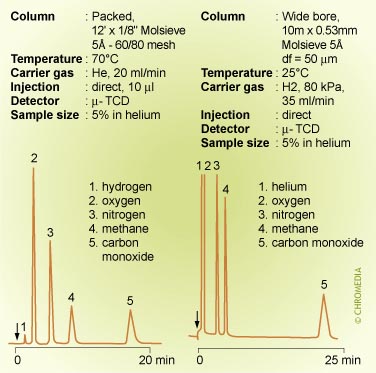Molsieve 5Å is a zeolite molecular sieve consisting of aluminium silicon oxide with a tunnel-like pore structure. The size of the pores is defined by the geometrical structure of the zeolite. Because of its very well defined pore size and its very high specific surface, it is possible to use this material as an adsorbent for GC.
| Molsieve 5Å column features:
|
A capillary coated with ![]() Molsieve 5Å combines all the advantages of capillary columns with molecular sieve adsorption chromatography. The result is a dramatic increase in separation efficiency with decreased analysis time.
Molsieve 5Å combines all the advantages of capillary columns with molecular sieve adsorption chromatography. The result is a dramatic increase in separation efficiency with decreased analysis time.
Fused silica capillary columns with an internal diameter of 0.32 mm are coated with a porous layer of about 30 μm of Molsieve 5Å particles to provide sufficient retention for permanent gases at ambient temperatures. Individual particle size is 2 μm or less. Only by using these fine particles, a stable adsorption layer (which is necessary for good permeability) can be obtained. The permeability is in the same order as for WCOT columns. A pressure of 0.5 bar for hydrogen results in a linear velocity of 30 cm/sec, which is the normal value for a 25 m x 0.25 mm ID open tubular column. The pressure drop across the column will always be somewhat higher because the resistance caused by the interaction of the carrier gas with a relatively rough porous layer in PLOT columns will be higher than with the smooth liquid coating in WCOT columns.
Separation mechanism
In general, there are two separation mechanisms responsible for the retention of molecular sieve columns:
- Molecular size. If the molecule is smaller than 5Å, it can diffuse inside the pores. Larger molecules cannot enter the pores and elute without retention. This mechanism (which is comparable to size exclusion) "sieves" the molecules larger than 5Å from those that are smaller.
- Adsorption kinetics that takes place on the surface both inside and outside the pores. In general this second mechanism is much stronger than the first one. Molecular sieves have an enormous surface area, resulting in very high retention factors. In particular the retention of compounds with
 dipolar interactions, such as carbon dioxide, will be very high.
dipolar interactions, such as carbon dioxide, will be very high.
| Applications on Molsieve 5Å:
|
Molsieve 5 Angstrom comparison packed vs capillary
 Did you ever try to explain separation to your employees or students? Well, try no more: Lee Polite did it for you in a way which is hard to beat. We will open up one example of his whiteboard class.
Did you ever try to explain separation to your employees or students? Well, try no more: Lee Polite did it for you in a way which is hard to beat. We will open up one example of his whiteboard class. 




